
How the audio experience is changing in the smart home era
Key Takeaways
- The integration of smart home devices profoundly impacts how we experience audio.
- Smart speakers and soundbars enhance user interaction with features like voice control.
- Wireless technologies allow for seamless and flexible sound experiences in any environment.
- Consumers benefit from personalized audio experiences tailored to individual preferences.
- Emerging trends focus on convenience, quality, and smart integrations.
Smart homes are not just about convenience; they're a complete transformation of how we interact with our surroundings, including audio. As technology advances, consumers find new ways to experience sound that is immersive, personalized, and integrated with their daily lives. In this article, we will explore how various devices, ranging from soundbars to wireless speakers, are evolving, thanks to the smart home era.
The rise of smart audio devices
Smart audio devices are becoming staples in our homes. They have moved beyond basic functionalities to include features that enhance interaction and personalization. The following table summarizes some key attributes of smart audio devices:
| Device Type | Key Features | Benefits |
|---|---|---|
| Smart Speakers | Voice commands, multi-room audio | Hands-free control, enhanced control over audio settings |
| Soundbars | Integrated smart technology, surround sound | Improved sound quality, seamless connectivity with other devices |
| Wireless Speakers | Bluetooth connectivity, smart integration with apps | Portability, ability to personalize audio settings via smartphone |
How smart home integrations enhance audio experiences
Smart home integrations allow for audio experiences that are not only convenient but also remarkably rich. By interlinking your sound devices with other smart home technologies, here are some ways your audio experience can be elevated:
- Centralized Control: Control all audio sources from a single device, such as your smartphone or smart home hub.
- Personalized Playlists: Use voice commands to play your favorite music playlists effortlessly.
- Automation: Set routines for different times of the day. For example, wake up to your favorite playlist or wind down with soothing sounds.
- Enhanced Surround Sound: Combine your soundbar with additional wireless speakers for a home theater experience.
Emerging trends in audio technology
With the rapid evolution of technology, several notable trends are shaping the future of audio experiences in smart homes. Let's explore these trends below:
Pros
- Improved sound quality with smart technology.
- Increased accessibility through voice commands.
- Flexibility and convenience in audio control.
- Enhanced personalization options.
Cons
- Potential compatibility issues across brands.
- Reliance on internet connectivity for certain features.
- Initial setup can be complex for some users.
1. Immersive sound experiences
The trend toward immersive sound experiences is on the rise. By utilizing advanced surround sound systems and smart audio configurations, users can create a cinematic experience within their homes.
2. Increased use of voice assistants
Voice assistants have become a game-changer in audio technology. The ability to voice-control devices not only makes them more user-friendly but also allows for hands-free interaction, creating a more immersive experience.
3. Focus on aesthetics
Smart audio devices are now being designed to blend seamlessly into home decor. This means that consumers can enjoy high-quality audio without compromising on style.
Personalizing your audio experience
Personalization is key. With new technologies, users have the ability to customize their audio settings, adjust EQ levels, and create their unique sound profiles. Consider exploring our page on buying guides for tips on selecting audio devices that match your preferences.
Challenges faced by consumers
As exciting as the smart audio landscape is, it's essential to consider potential challenges consumers may face:
- Understanding the full range of features available on smart devices.
- Ensuring devices work cohesively without frustrating compatibility issues.
- Managing an ever-growing number of apps for device control.
Conclusion
The audio experience is undergoing a significant transformation in the smart home era. With advancements in technology and increasing connectivity between devices, consumers can look forward to a more personalized, immersive, and convenient audio journey. Embracing these changes allows for a richer interaction with audio while cultivating an adaptable and smart living environment.
For more insights into the latest trends in audio technology, be sure to check our dedicated category on trends in audio technology.
